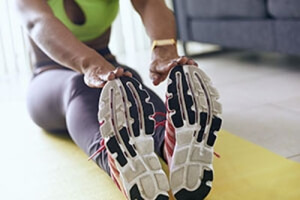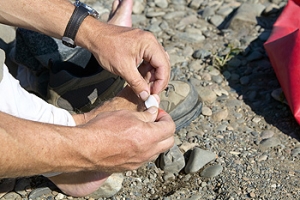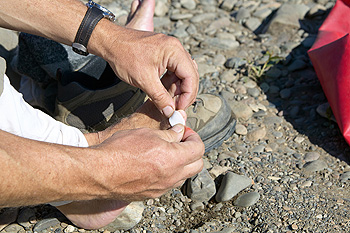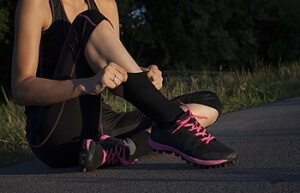
How To Teach Children About Proper Foot Care
 Your child may begin to walk at about 12 months of age. Recent research has shown that it’s beneficial to walk barefoot as much as possible, which may help strengthen the foot muscles. It’s important to measure the feet every few months in the early years to ensure a proper fit while choosing shoes. As your child gets older, common ailments that can occur may include athlete’s foot, ingrown toenails, and plantar warts. It’s crucial to maintain daily foot care, which includes washing the feet in lukewarm water and drying thoroughly between the toes. Additionally, complaints about heel pain can be a common occurrence, typically resulting from playing sports. If the pain becomes severe, a consultation with a podiatrist may be suggested to alleviate any discomfort and to learn about possible treatment options.
Your child may begin to walk at about 12 months of age. Recent research has shown that it’s beneficial to walk barefoot as much as possible, which may help strengthen the foot muscles. It’s important to measure the feet every few months in the early years to ensure a proper fit while choosing shoes. As your child gets older, common ailments that can occur may include athlete’s foot, ingrown toenails, and plantar warts. It’s crucial to maintain daily foot care, which includes washing the feet in lukewarm water and drying thoroughly between the toes. Additionally, complaints about heel pain can be a common occurrence, typically resulting from playing sports. If the pain becomes severe, a consultation with a podiatrist may be suggested to alleviate any discomfort and to learn about possible treatment options.
Making sure that your children maintain good foot health is very important as they grow. If you have any questions, contact one of our podiatrists of Apple Podiatry Group. Our doctors can provide the care you need to keep you pain-free and on your feet.
Keeping Children's Feet Healthy
Having healthy feet during childhood can help prevent medical problems later in life, namely in the back and legs. As children grow, their feet require different types of care. Here are some things to consider...
Although babies do not walk yet, it is still very important to take care of their feet.
Avoid putting tight shoes or socks on his or her feet.
Allow the baby to stretch and kick his or her feet to feel comfortable.
As a toddler, kids are now on the move and begin to develop differently. At this age, toddlers are getting a feel for walking, so don’t be alarmed if your toddler is unsteady or ‘walks funny’.
As your child gets older, it is important to teach them how to take care of their feet.
Show them proper hygiene to prevent infections such as fungus.
Be watchful for any pain or injury.
Have all injuries checked by a doctor as soon as possible.
Comfortable, protective shoes should always be worn, especially at play.
If you have any questions please feel free to contact our offices located in Arlington Fort Worth, And Flower Mound, TX . We offer the newest diagnostic and treatment technologies for all your foot and ankle needs.
What to Do to Keep Your Child’s Feet Healthy
Being a parent involves caring for your child in every way you can. You make sure they are eating the right food, being nice to others, and staying out of any trouble. However, it is also important that you are watchful of their health, more specifically their foot health. Maintaining good foot health in childhood is important in preventing later conditions in life from happening. As children continue to develop, their feet require different techniques of care. Here are some various ways in which you can help your child’s feet stay healthy.
A baby needs a lot of care and attention overall, but the importance of their feet should never be forgotten. Before a baby turns one, their feet change and develop greatly. It is important that during this time, a mother avoids putting tight socks on their child. She should also encourage movement of their feet so the baby can begin to feel more comfortable using them.
As a baby enters the toddler years of his or her life, they are begin to walk around. When your baby begins to take those first steps, it is crucial that they are wearing protective shoes on their feet. As a mother that is observant of your child’s feet, you may notice changes in them. This is completely normal as the feet are becoming susceptible to the activity of walking. It is normal for a toddler to be a bit unsteady or to “walk funny” at first.
When your child grows out of their toddler years, it is important that you begin to show him or her how to care for their feet on their own. Practice with your child proper hygiene in order to prevent foot fungus or infection. Since children are constantly on the move, it is crucial to be cautious of any accidents or injuries that might occur. If an injury occurs, it is advised that you take your child to be examined by a doctor immediately. Since your child is still growing, particular injuries can shift the way in which a bone or other important part of the foot is developing.
Babies and kids are always changing and growing. Your job as a parent is to make sure they stay healthy and making sure they are properly maintained. This involves proper foot care and making sure the feet stay healthy. Following this guide, your child can live a long and happy life.
Stretches to Help Your Feet
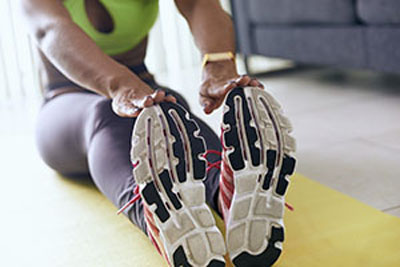 If you have a job where standing is done most of the day, it’s beneficial to stretch the tendons and muscles of the feet. Stretching the feet will not only feel good but help reduce any potential swelling the feet may incur, in addition to alleviating any pain that can develop. By wearing shoes and socks that fit comfortably, the chances are favorable that your feet will not feel any discomfort at the end of the day. The following is a stretching exercise the feet may benefit from when practiced regularly. One such exercise is called “split squats,” and this is demonstrated by placing the right leg forward and pulling the left leg backward. This will provide a large distance between the feet. Slowly bend down, and a gentle stretch in the feet can be felt when the back knee touches the floor. It’s suggested to rise slowly, and repeat on the other side. Recent research has suggested that stretching the feet is crucial in maintaining strong arches, muscles, and tendons. Please consider a consultation with a podiatrist for additional information about working on your feet.
If you have a job where standing is done most of the day, it’s beneficial to stretch the tendons and muscles of the feet. Stretching the feet will not only feel good but help reduce any potential swelling the feet may incur, in addition to alleviating any pain that can develop. By wearing shoes and socks that fit comfortably, the chances are favorable that your feet will not feel any discomfort at the end of the day. The following is a stretching exercise the feet may benefit from when practiced regularly. One such exercise is called “split squats,” and this is demonstrated by placing the right leg forward and pulling the left leg backward. This will provide a large distance between the feet. Slowly bend down, and a gentle stretch in the feet can be felt when the back knee touches the floor. It’s suggested to rise slowly, and repeat on the other side. Recent research has suggested that stretching the feet is crucial in maintaining strong arches, muscles, and tendons. Please consider a consultation with a podiatrist for additional information about working on your feet.
While working on the feet, it is important to take the proper care of them. For more information about working on your feet, contact one of our podiatrists from Apple Podiatry Group. Our doctors will treat your foot and ankle needs.
Working on Your Feet
Standing on your feet for long periods of time can cause stress and pain in your feet. Your whole body may experience change in terms of posture, back pain, bunions, callouses and or plantar warts. There are ways to avoid these conditions with proper foot care, smart choices and correct posture.
Positive Changes
Negative heeled shoe – Choosing this shoe type places the heel slightly lower than the ball of the foot. These are great for overall foot health. Find shoes that fit you correctly.
Go barefoot – Our feet were not designed to be enclosed for all hours of the day. Try to periodically expose your feet to air.
Eliminate Pain
Foot Exercises – Performing simple exercises, incorporating yoga and doing stretches are beneficial. This will allow increased blood flow to the area and muscles of the foot.
Achilles tendon – Stretching the foot out flat on the floor will relax the calf muscles and tendon. These exercises can be performed almost anywhere. Make sure you add these exercises to your daily regimen.
With a little bit of this information and knowing more about foot health, you will notice changes. Foot stretches and proper footwear will help with pain and prevent further issues.
If you have any questions please feel free to contact our offices located in Arlington Fort Worth, And Flower Mound, TX . We offer the newest diagnostic and treatment technologies for all your foot and ankle needs.
Working on Your Feet
Foot care is important regardless of your profession, but those who work on their feet must pay special attention. Bunions, calluses, blisters, and plantar warts are just a few of the many conditions that can arise after standing all day. While painful at their worst, these conditions can easily be avoided with the right foot care. This includes both appropriate footwear and proper posture—important elements that affect the health of your feet.
Choosing appropriate footwear means choosing a shoe that has a negative heel. This means that the heel is slightly lower than the ball of your foot, which places less of a strain. If you have a profession that requires you to be on your feet all day, investing in a pair of high-quality shoes is pertinent. High-quality shoes can be purchased from a respected manufacturer that emphasizes foot care and foot health.
Despite the regularity of wearing shoes, the feet are naturally not designed to be enclosed. Regular “barefoot” time for your feet can be beneficial for foot health. Among other methods, allowing your feet to breathe can help alleviate the pain and pressure your feet may be experiencing from being on your feet all day.
Simple foot exercises and yoga positions can help improve both the health and function of your feet. Active foot exercises that create movement will stimulate your foot’s blood flow and circulation, and yoga positions that place your feet flat onto the floor will stretch out their muscles. Yoga is particularly beneficial for your Achilles tendon and calf muscles, which are areas that can become especially problematic if not taken care of. Foot exercises and yoga positions can be easily performed every day at virtually any location and any time; whether it is at the office, at the gym, or at home right before you go to bed. Simple stretching can increase your foot health by miles.
The foot pain you experience after lengthy hours working on your feet may seem inevitable and unavoidable; in reality, however, that is not the case. Wearing proper footwear and performing simple foot exercises and stretches can help ease foot pain and allow you to truly avoid frustrating foot problems.
Your feet can easily be kept healthy with some education and a little effort. Pain that begins at the feet can eventually affect the whole body. Begin taking care of your feet now!
How to Prevent Blisters on the Feet
If you see a small area filled with clear fluid on your foot, you may have what is referred to as blister. It’s common for joggers to develop blisters on the feet, and their running is often compromised. Pain and discomfort are often associated with blisters, and the best way to avoid this condition from occurring is to be aware of how to prevent it. It’s important to wear running shoes that fit correctly, and this includes choosing a shoe size that is bigger than shoes that are worn while not running. Additionally, there are socks that are designed specifically for running, and blisters may not form as rapidly when worn. Typically, the best way to treat a blister is to leave it alone, and it will heal on its own. If it bursts and becomes infected, a bandage may be necessary to cover it for protection. Please schedule a consultation with a podiatrist if you would like information about blisters on the feet and how to treat them.
Blisters are prone to making everyday activities extremely uncomfortable. If your feet are hurting, contact one of our podiatrists of Apple Podiatry Group. Our doctors can provide the care you need to keep you pain-free and on your feet.
Foot Blisters
Foot blisters develop as a result of constantly wearing tight or ill-fitting footwear. This happens due to the constant rubbing from the shoe, which can often lead to pain.
What Are Foot Blisters?
A foot blister is a small fluid-filled pocket that forms on the upper-most layer of the skin. Blisters are filled with clear fluid and can lead to blood drainage or pus if the area becomes infected.
How Do Blisters Form?
Blisters on the feet are often the result of constant friction of skin and material, usually by shoe rubbing. Walking in sandals, boots, or shoes that don’t fit properly for long periods of time can result in a blister. Having consistent foot moisture and humidity can easily lead to blister formation.
Prevention & Treatment
It is important to properly care for the affected area in order to prevent infection and ease the pain. Do not lance the blister and use a Band-Aid to provide pain relief. Also, be sure to keep your feet dry and wear proper fitting shoes. If you see blood or pus in a blister, seek assistance from a podiatrist.
If you have any questions, please feel free to contact our offices located in Arlington Fort Worth, And Flower Mound, TX . We offer the newest diagnostic and treatment technologies for all your foot care needs.
Blisters on the Feet
Blisters are a common ailment of people who wear shoes that are either too tight or rub against the feet in an uncomfortable way. Knowing the basics of blisters is important for understanding how they are formed and what treatments should be used for them.
A blister on the foot, or any other part of the body, is a small pocket that is filled with fluid. It usually forms on the upper layer of the skin because these layers are loose enough to allow a blister to form. The most common fluid in a blister is just a clear, watery-like fluid that usually isn’t cause for concern. However, blisters can fill up with blood if they are deep enough and pus if they have become infected with bacteria.
Blisters almost always form on the feet due to shoes rubbing up against the foot, where the friction causes blisters. These can occur after you have walked for a long period of time or when your shoes do not fit you properly. Your feet are also more prone to blisters if they are moist, so keeping them dry and clean is one preventative step you can take.
Preventing infection should be the number one concern when treating blisters, as well as relieving the pain they can cause. Using a bandage to cover up the blister will help it heal and prevent bacteria from entering it. New skin will form under the blister and eventually cause it to pop. You can also take a sterilized pin and try to pop it yourself.
If the blister is filled with pus or blood, seeking treatment from a doctor is ideal. Antibiotics may need to be taken in order to completely eliminate the bacteria inside the blister. See a doctor to have an antibiotic prescribed.
The best way to treat blisters is to prevent them all together. Keeping your feet dry and making sure that your shoes fit properly are just two of the steps you can take to prevent blisters. Shoes that are too tight or shoes that are too loose and allow your feet to slide in them will cause blisters. Applying a bandage to an area where you think a blister is about to form is another way you can prevent them.
Wounds That Don't Heal Need to Be Checked
Are Runners Affected by Plantar Fasciitis?
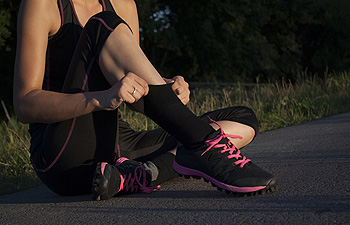 There is a thick band of tissue that runs along the bottom of the foot connecting the heel to the toes. If this tissue should become torn and inflamed, it is referred to as a condition called plantar fasciitis. There are several functions of the plantar fascia, including maintaining the foot’s balance and how the walk is controlled. If this portion of tissue should become injured, the discomfort and pain that’s experienced may be disabling. One of the earliest signs of a tear or injury is pain that’s felt after sleeping when the first step is taken. There are preventative stretches that can be performed to strengthen the foot, which may help to avoid injury. It’s equally important to cease all activities that cause any discomfort, in addition to wearing the right running shoes with adequate arch support. If you suffer from this ailment, it’s suggested to consult with a podiatrist for additional information about plantar fasciitis.
There is a thick band of tissue that runs along the bottom of the foot connecting the heel to the toes. If this tissue should become torn and inflamed, it is referred to as a condition called plantar fasciitis. There are several functions of the plantar fascia, including maintaining the foot’s balance and how the walk is controlled. If this portion of tissue should become injured, the discomfort and pain that’s experienced may be disabling. One of the earliest signs of a tear or injury is pain that’s felt after sleeping when the first step is taken. There are preventative stretches that can be performed to strengthen the foot, which may help to avoid injury. It’s equally important to cease all activities that cause any discomfort, in addition to wearing the right running shoes with adequate arch support. If you suffer from this ailment, it’s suggested to consult with a podiatrist for additional information about plantar fasciitis.
Plantar fasciitis can be very painful and inconvenient. If you are experiencing heel pain or symptoms of plantar fasciitis, contact one of our podiatrists from Apple Podiatry Group. Our doctors can provide the care you need to keep you pain-free and on your feet.
What Is Plantar Fasciitis?
Plantar fasciitis is the inflammation of the thick band of tissue that runs along the bottom of your foot, known as the plantar fascia, and causes mild to severe heel pain.
What Causes Plantar Fasciitis?
- Excessive running
- Non-supportive shoes
- Overpronation
- Repeated stretching and tearing of the plantar fascia
How Can It Be Treated?
- Conservative measures – anti-inflammatories, ice packs, stretching exercises, physical therapy, orthotic devices
- Shockwave therapy – sound waves are sent to the affected area to facilitate healing and are usually used for chronic cases of plantar fasciitis
- Surgery – usually only used as a last resort when all else fails. The plantar fascia can be surgically detached from the heel
While very treatable, plantar fasciitis is definitely not something that should be ignored. Especially in severe cases, speaking to your doctor right away is highly recommended to avoid complications and severe heel pain. Your podiatrist can work with you to provide the appropriate treatment options tailored to your condition.
If you have any questions please feel free to contact our offices located in Arlington Fort Worth, And Flower Mound, TX . We offer the newest diagnostic and treatment technologies for all your foot and ankle needs.
Plantar Fasciitis
The plantar fascia is a connective tissue in the heel that stretches across the bottom length of your foot. Plantar fasciitis occurs when the connective tissue becomes inflamed, causing heel pain and discomfort during physical activity. Although the condition is completely treatable, traditional methods can take up to a year to start becoming effective.
Plantar fasciitis is caused by a number of everyday activities, so understanding the condition is important for managing and treating it. One of the most common causes of plantar fasciitis is excessive running, especially with improper fitting or non-supportive shoes. Too much exercise can lead to the plantar fascia being overworked and overstretched, which can cause tears in the tissue. Along with improper fitting shoes, pronation, the rolling of the feet inward, is a common cause of plantar fasciitis. If not treated properly, the plantar fascia becomes overstretched and starts to tear, causing inflammation.
Despite the common causes of plantar fasciitis, there are many different treatment options. For less severe cases, conservative home remedies include taking anti-inflammatory drugs to alleviate pain, applying ice packs to the bottom of your foot and heel, slowly stretching and exercising your feet to re-strengthen the tissue, and using orthotic devices are all ways to help manage your plantar fasciitis.
For more severe cases, shockwave therapy has become a common solution for plantar fasciitis. Shockwave therapy can effectively break up the tissue on the bottom of your foot which facilitates healing and regeneration. This fights the chronic pain caused by plantar fasciitis. Even if this doesn’t work, surgery is always a final option. Surgery on the tissue itself can be done to permanently correct the issue and stop the inflammation and pain in your heels.
No matter what the case may be, consulting your podiatrist is the first and best step to recovery. Even the slightest amount of heel pain could be the first stage of plantar fasciitis. Untreated symptoms can lead to the tearing and overstretching of tissue. Because the tearing of tissue can be compounded if it remains ignored, it can evolve into a severe case. The solution is early detection and early treatment. Talk to your podiatrist about the possibilities of plantar fasciitis if you’re experiencing heel pain.



